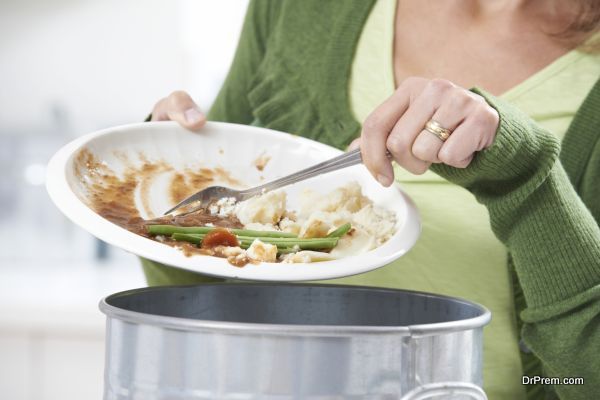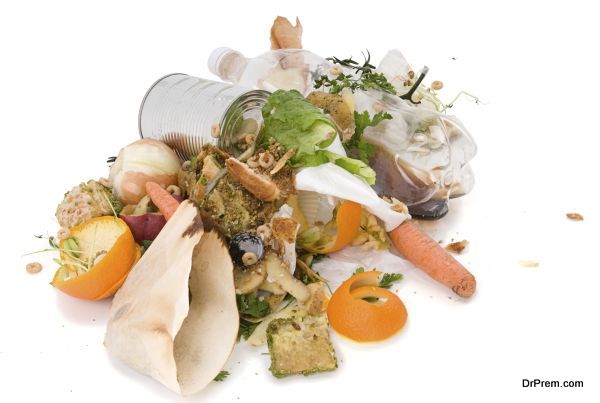Before emptying trash, have you ever thought of the amount of food that is being wasted by you per day! As per the surprising figure reported by a survey; an average household creates 1.28 pounds of daily waste that can be equated with almost 14% of the entire family’s food purchase. It is still more shocking to know that, almost 95% of your daily thrown food waste is either a part of the landfill or combustion facilities; wherein the rotting food releases methane gas that is 25% more potent than C02 to produce green house effect.
About 60% of the food supply in US is wasted in homes and other food catering services. Whereas another report suggests that almost about 89 million tonnes of food is thrown every year in the European countries. Thus, food wastage not only restricts the number of people being fed in the world, but also accounts for substantial economic burden to the society. According to a recent estimate, food worth of $940 billion is wasted each year!
Apparently, reducing food wastage and loss should be outlined as primary agenda to achieve an economically viable food future. In this regard, number of affordable and practical strategies could be implemented, to achieve relatively faster gains.
Why is food wasted?

It is evident that knowingly or unknowingly, we all waste food to some or the other extent. In general, the two main parameters for food wastage are, either it has been purchased or prepared more than the amount actually needed, or the consumer has forgotten to utilize it on time. In order to move on with detailed analysis, some of the more specific reasons that have been identified are as follows.
- More than required quantity of food is prepared or put on the plate and ultimately has to be treated as leftover.
- Some food like fruits or other leftovers that are kept at the backside of the fridge and are never reused. These foods come under the category of partially used food and are thrown in the dust bin.
- Some of the perishable foods such as dairy, meat, and fish products needed to be thrown in the dust bin as they pass, use by date or best before date.
- Some other consumables such as badly smelling food or food with fungal or bacterial growth had a chance of utilization but were not managed properly.
- It also may happen that the food being prepared sometimes is just thrown for being tasteless.
Simple yet effective ways to reduce food waste
Minimizing this wastage should be prioritize in such a way, that some methods should be incorporated to cut down loss close to the farm, while other strategies should reduce wastage close to the fork.
- Incorporation of upgraded storage method
Crude ways to store farm fresh food can be drastically lost due to factors like pests, spoilage, rains, and/or transportation damage. With technological upgradation, it is now possible to store the food, in an interlocking plastic storage to prevent pest attacks and weather damage of the food,to keep it farm fresh for months. The food and the agricultural organization has developed more than 45,000 small, metal storage cabinets that have zeroed down the food loss at the time of storage.
- Useful redistribution of food

It has been observed that many times ordered food by grocer can’t be entirely sold out and is hence wasted, in spite of being in perfect quality. This kind of food loss can be prevented by just redistributing the same food to some NGO or food banks; wherein the food is offered to poor people, to minimize the food loss.
- Check expiry and manufacturing date before buying your grocery
According to the recent survey, conducted by Waste and Resources Action Programme; it is evident that one-fifth of the food that has been purchased at the household level is thrown, because it was incorrectly purchased without checking expiry. Thus, some food loss can be avoided by checking the date of expiry of the food, before purchasing the same.
- Reduce portion sizes
Huge sized food portion, can many times lead to unusually large food loss, especially in restaurants or at buffet parties. This type of wastage can be significantly reduced by watching portion size or by offering the small sized menus in restaurants and cafeterias.
Apart from these strategies, some innovative ways like awareness campaigns, waste measurement checks, setting up targets to minimize food loss, minimizing post harvest loss, etc. can be implemented to reduce food wastage and loss at the war level.
Considering the huge food loss and wastage, it is imperative to incorporate precautionary plan of actions to reduce it. In developed countries, most of the loss is during production and storage;in this regard, investing in better infrastructure is critical. In developed countries, however, maximum wastage would be at the consumer level, which can be reduced by better awareness indeed.




